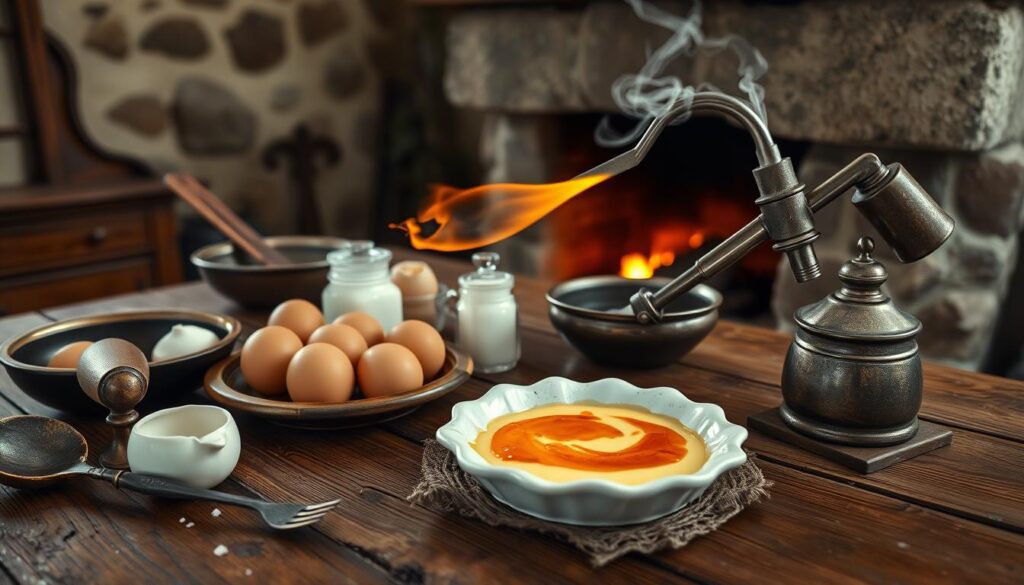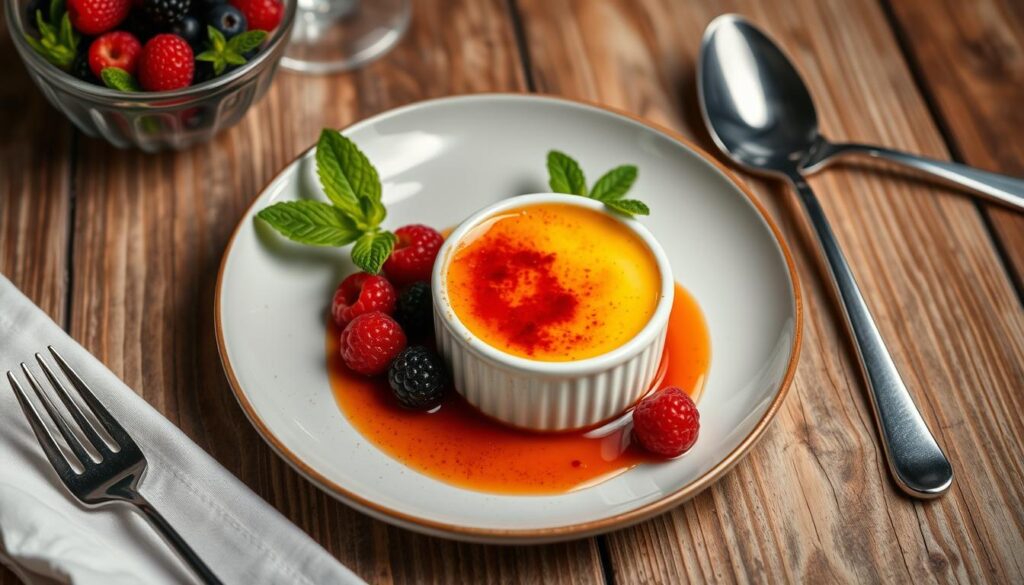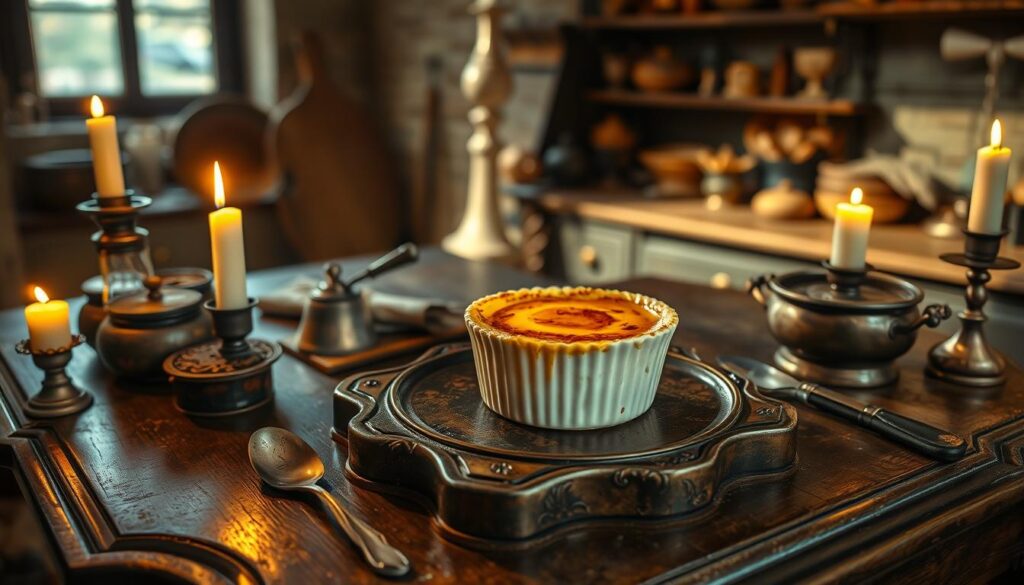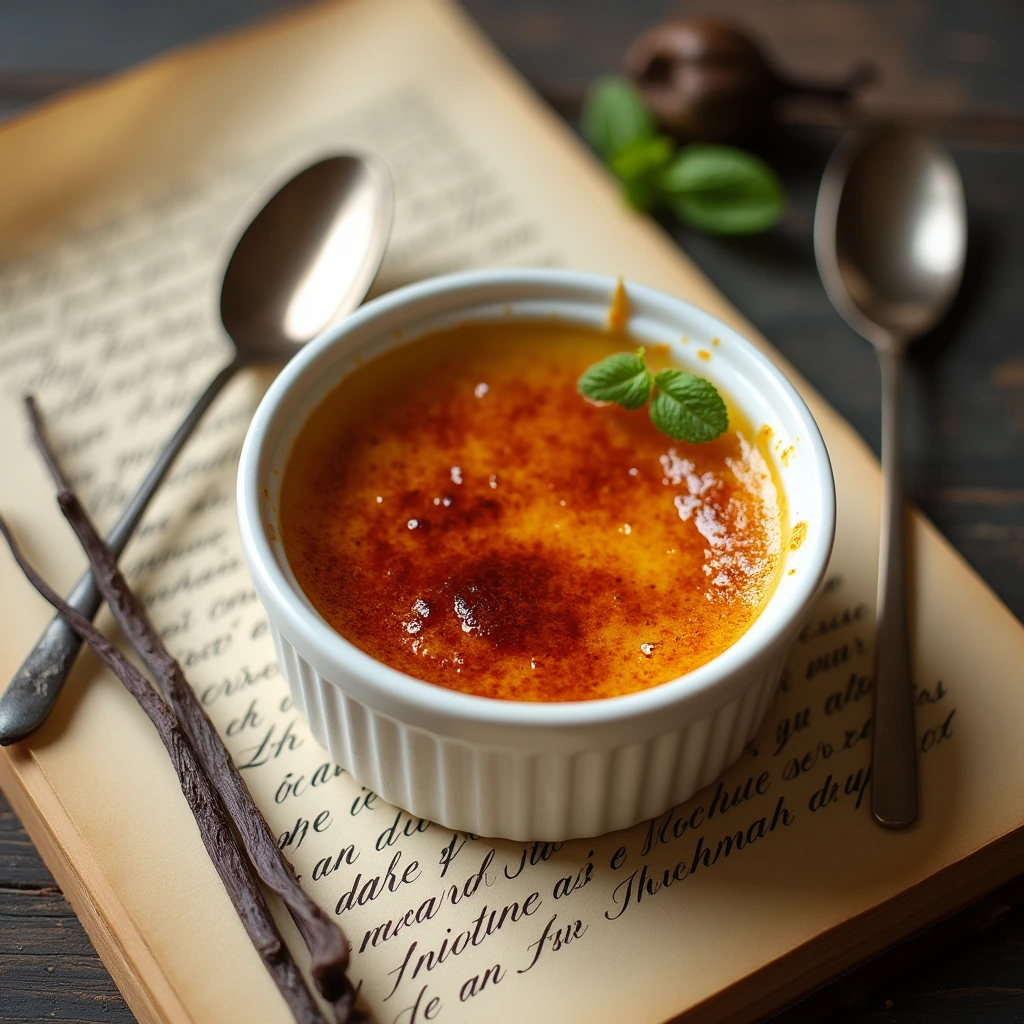The term crème brûlée means “burnt cream” in French. It shows its rich taste and special cooking way. This dessert has a rich history of crème brûlée that links with many European cultures. Countries like France, England, and Spain all have their own stories about it.
In this article, we’ll explore the origin of crème brûlée. We’ll see how its culinary importance and cultural impact have made it a favorite dessert globally.

Key Takeaways
- The earliest known reference to crème brûlée appears in a 1691 cookbook by François Massialot.
- Various countries, including France, England, and Spain, claim to be the birthplace of crème brûlée.
- This dessert became widely popular in the United States during the 1980s.
- Crème brûlée is celebrated annually on July 27th.
- The dessert features a creamy custard base topped with a caramelized sugar crust.
The Definition of Crème Brûlée
Crème brûlée is a rich and indulgent classic dessert. It’s known for its delightful contrast of textures. The base is a creamy custard made from egg yolks, sugar, and heavy cream.
A hard layer of caramelized sugar tops the custard. This layer offers a satisfying crunch when tapped with a spoon.
The definition of crème brûlée goes beyond its ingredients. It’s often made in 6-8 ounce ramekins for the perfect balance. This dessert can be stored in the fridge for 2-3 days, making it great for gatherings.
While many love crème brûlée for its flavor, it’s not a healthy option. It has high sugar and calorie content. But, there are healthier versions like chocolate and pumpkin crème brûlée.

The true joy of crème brûlée is its rich custard and the caramelized topping. This topping adds a special touch, making it a timeless dessert.
Historical Background of Crème Brûlée
The story of crème brûlée is a mix of cultures. It’s hard to say who first made it, with England, Spain, and France all saying they did. But, it started with custard recipes from the Middle Ages in Europe.
In England, they made a version called burnt cream. Spain has crema catalana. These show how different places made their own versions of this dessert. By the 19th century, “crème brûlée” became well-known in French cooking.
Thomas Jefferson helped bring crème brûlée to the US. It became popular in the 1950s and 1960s. Chefs started adding flavors like vanilla, chocolate, and citrus to it.
Over time, crème brûlée has changed a lot. You can find it in ice cream and cupcakes, but it’s always the same in taste. Its mix of textures and rich taste makes it loved all over the world.

| Aspect | Details |
|---|---|
| Origins | England, Spain, and France all claim invention |
| Custard Roots | Dating back to the Middle Ages in Europe |
| 19th Century Popularity | The name “crème brûlée” became widespread |
| American Introduction | Thomas Jefferson brought it to the US |
| Modern Variations | Includes ice cream, cheesecake, and cupcakes |
Why Is It Called Crème Brûlée?
The term crème brûlée means “burnt cream.” It shows how the dessert is made by caramelizing sugar on top of a creamy custard. This method is key to understanding the dessert’s unique taste and texture.
Meaning of the Term
Crème brûlée is all about rich flavors and textures. The “cream” part is the smooth custard base. The “burnt” part is the caramelized sugar crust that adds a delightful contrast. This mix of textures has made it a favorite around the world.
Culinary Significance
Crème brûlée is more than just a tasty treat. It was first seen in the 1691 French cookbook, Le Cuisinier Royal et Bourgeois. Over time, it has moved from royal courts to modern bistros, showing its enduring appeal. Its popularity in the 1970s and praise from food critics prove its status as a symbol of luxury in cooking.
The First Recorded Recipe
The story of crème brûlée starts with a key moment in cooking history. The first recipe for crème brûlée comes from François Massialot, a chef from the late 17th century. His cookbook is a key to understanding this favorite dessert.
François Massialot’s Contribution
François Massialot’s cookbook, “Le Cuisinier Royal et Bourgeois,” was published in 1691. It has the earliest known recipe for crème brûlée. This book shows the detailed French cooking techniques and introduces caramelizing sugar on custard.
Massialot’s way of making this dish set the stage for its widespread popularity. The cookbook gives us a peek into the fancy dining of French nobility back then.
Details of the 1691 Cookbook
“Le Cuisinier Royal et Bourgeois” explains the key ingredients and steps for making crème brûlée. It talks about mixing egg yolks and milk, and the caramelized sugar on top. This book is a major historical find, shaping how crème brûlée was made in French and global kitchens.
Over time, this traditional recipe has led to many variations. It shows the important role of François Massialot and his cookbook in cooking history.
Crème Brûlée’s Claim to Fame: France, England, or Spain?
Crème brûlée is a dessert with a rich history. France says it comes from their cooking traditions, with mentions in cookbooks from the 17th century. But England also has a claim with Trinity cream, a dessert with a caramelized sugar layer on top of creamy custard.
Spain has “Crema Catalana,” which is older than both. It has unique cooking methods that make it stand out. Each country’s version tells a story of culinary traditions and techniques across Europe.
France’s Assertion of Origins
The French believe crème brûlée shows their culinary greatness. It first appeared in a cookbook by François Massialot in 1691. It quickly became a favorite in fancy restaurants.
England’s Trinity Cream
In England, it’s called Trinity cream, named after Trinity College in Cambridge, introduced in 1879. It’s also known as Cambridge burnt cream. The college’s arms were even branded on top, adding to its prestige.
Spain’s Crema Catalana
Spain’s Crema Catalana is a medieval dessert. It’s different from crème brûlée and Trinity cream, with cinnamon and lemon zest for flavor. These differences highlight the dessert’s rich history and cultural ties across Europe.
| Region | Dessert Name | Key Features | Historical Reference |
|---|---|---|---|
| France | Crème Brûlée | Rich custard, caramelized sugar | First recipe in 1691 |
| England | Trinity Cream | Impressed college arms, similar preparation | Introduced in 1879 |
| Spain | Crema Catalana | Cinnamon and lemon zest, different preparation | Dates back to the Middle Ages |
Crème Brûlée in American Culture
Crème brûlée has become a favorite dessert in America. It was first introduced by Thomas Jefferson, who brought it to the White House. This dessert symbolized a connection to France, captivating many dessert lovers.
Thomas Jefferson and the Dessert in the White House
Thomas Jefferson loved French cuisine and introduced crème brûlée to America. He served it at state functions, raising its status. This set the stage for its growing popularity in the U.S.
Rise of Popularity in the 1980s
The 1980s saw a big rise in crème brûlée’s popularity. It became a favorite in upscale dining. Restaurants put it on their menus, and celebrity chefs helped it reach home kitchens.
Impact of La Cirque on American Palates
La Cirque in New York City was key in making crème brûlée popular. Chef Sirio Maccioni and Pastry Chef Dieter Schorner perfected it. Their version became a symbol of luxury dining, inspiring many others.
Preparation Methods for Crème Brûlée
The world of making crème brûlée is a mix of old traditions and new ideas. A classic recipe starts with heavy cream, egg yolks, sugar, and vanilla. This mix makes the custard base, ready for a delicious dessert.
Using a bain-marie while baking is key. It cooks the custard gently. This makes it silky without curdling.
Ingredients and Techniques
Getting the right mix of ingredients is important for a smooth custard. Chefs might use all heavy cream or mix milk and cream. For example:
- 2 parts whole milk to 1 part heavy cream
- 1 part heavy cream to 1 part whole milk
Choosing the right dairy is key for texture. Use 1 egg yolk per 1/2 cup of cream and 1 1/2 teaspoons of sugar. Beginners might add 1/2 teaspoon of cornstarch to prevent curdling.
Modern Variations of the Recipe
New twists on crème brûlée add exciting flavors. Chefs now use chocolate, espresso, or fruits. These flavors need at least thirty minutes to soak into the cream.
Changing baking temperatures and chilling times also evolve the dessert. Aim for a custard at 170° F before cooling. Chill it for at least four hours.
To get the perfect caramelized sugar, use a torch. Sprinkle 1 tablespoon of sugar on each custard before torching. This creates a nice contrast with the smooth custard below. Making crème brûlée is a mix of tradition and creativity.
Crème Brûlée and Its Variations
Crème brûlée has grown beyond its classic form. Chefs and dessert fans now explore many new versions. Vanilla is a favorite, but there are also chocolate, spiced pumpkin, and pistachio flavors. These show how versatile this dessert can be.
Different Flavor Profiles
Crème brûlée is simple, made from egg yolks, cream, and sugar. This base lets chefs add unique flavors. They’ve even made savory versions, showing it can be more than just a sweet treat.
This creativity makes crème brûlée appealing to many. It’s a modern twist on a classic dessert.
Global Influence of the Dessert
Crème brûlée has traveled the world, leaving a mark on desserts everywhere. It’s been adapted in many ways, each adding a local twist. Its creamy base and caramelized top are loved globally.
As people enjoy and reinvent crème brûlée, its status as a classic dessert is clear. It has become a favorite around the world.
FAQ
What is the main ingredient in crème brûlée?
The main ingredients in crème brûlée are heavy cream, sugar, egg yolks, and vanilla.
How do you achieve the crunchy topping on crème brûlée?
To get the crunchy topping, you need to caramelize sugar. You can use a kitchen torch or broiler after baking the custard.
Can crème brûlée be made with flavors other than vanilla?
Yes, you can make crème brûlée with many flavors. Try chocolate, espresso, citrus, or even savory elements.
How should crème brûlée be served?
Serve crème brûlée at room temperature. This contrasts the creamy custard with the crunchy caramelized sugar on top.
Where did crème brûlée originate?
Crème brûlée’s origins are debated. France, England (Trinity Cream), and Spain (Crema Catalana) all claim it, each with their own historical recipe.
What is the historical significance of François Massialot?
François Massialot was a key chef. He included the first recorded crème brûlée recipe in his 1691 cookbook. This shows its early role in French cuisine.
How did crème brûlée become popular in American culture?
Thomas Jefferson introduced crème brûlée to America. It gained fame in the 1980s with La Cirque restaurant’s feature.
What are the different methods for preparing crème brûlée?
Traditional crème brûlée mixes cream, egg yolks, and sugar. Then, it’s baked in a bain-marie. Modern recipes add flavors and techniques for today’s tastes.
Why is crème brûlée considered a classic dessert?
Crème brûlée is a classic because of its rich history and wide appeal. It has been enjoyed across cultures, keeping its signature taste and texture.

